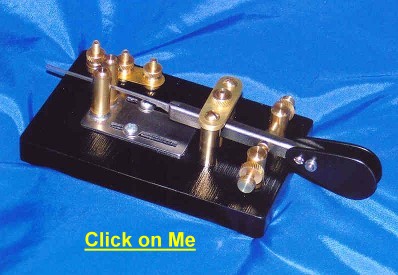Side
Swiper Page
 Here
is the side swiper (cootie) key made for me by Joe
K8LKC. He did a beautiful job on it. The flat spring and dual
positioning pillars were my idea, though Joe did all the
experimentation and construction.
Here
is the side swiper (cootie) key made for me by Joe
K8LKC. He did a beautiful job on it. The flat spring and dual
positioning pillars were my idea, though Joe did all the
experimentation and construction.
The side swiper key was a
stopgap invention that showed up after the straight key and before
the bug. Telegraph operators using straight keys for hours every day
developed a "glass arm" which we now call Carpel Tunnel
syndrome. Changing from the up-down pumping motion of the straight
key to the back and forth sideways (swinging) motion of the side
swiper relieved most of the operator fatigue and many a glass
arm.
The use of a side swiper is very different from other
keys. With a Bug, a single paddle keyer, or an iambic keyer, all
dashes are made using the index finger and all of the dots are made
using the thumb. The side swiper is a completely different beast.
Dots and/or dashes are made with either the thumb or finger. The best
way to explain it is you always move the swing arm in the other
direction to make the next dot or dash. You can start a character
from either direction. It doesn't matter. Just keep the critter
swinging the other way. Therefore the motions you make to spell a
word (like you name) can be different each time you do it. It depends
where the paddle was when you entered the word. Like the straight
key, neither dots nor dashes are automatically made. All of the
timing is up to the operator.
If it all seems confusing, it
is, and there in lies the challenge.
Here is a "You-Tube"
video made by IK0YGI who gives an introduction to using the side
swiper key:

http://www.youtube.com/watch?v=ZfLrgYHIpjo
My Side Swiper fist has a heavy "accent"
(more pronounced the faster I go). I think this is typical for Side
Swiper users and here is my theory to explain it:
The operator tries to keep momentum going in
their wrist minimizing the energy lost and reducing operator fatigue.
The operator moves the paddle in one direction until the electrical
contacts on that side of the key close. The hand continues to
compress placing increasing pressure on the closed contact for the
duration of the code element ("dit" or "dah").
The increasing pressure effectively converts the momentum of the
moving hand into stored potential energy. When the element is
completed, the hand starts to uncompress, moving the paddle in the
opposite direction and converting the stored potential energy back
into momentum. This process is repeated in both directions to send
the morse code. The closer this motion resembles an uninterrupted
pendulum rhythm, the more energy efficient it becomes resulting in
less operator fatigue. Unfortunately, morse code does not follow this
rhythm. What results is the spacing between letters and words get
shortened (pushed together) and dits and dahs get closer to having
the same duration (instead of 3:1 weighting) . In fact both dits and
dahs get longer due to the unconscious desire of the operator to
gather up as much of the momentum into stored potential energy, there
by reducing the physical effort of sending the code. To avoid
sending with this "accent", the operator has to consciously
focus on what they are sending and fight the natural tendency to
break into the pendulum rhythm. This is easier to accomplish when QRS
than when QRQ.
I hope you like my side swiper fist.
If you find it uncomfortable to copy, let me know. I will be happy to
switch over the my bug or keyer.
I learned to use the swiper
with my weak hand (left hand). I did this to avoid "training"
my right hand/brain to key in this manner, thinking it would ruin my
ability to use my Bug and my Iambic keyer. I figure using the other
half of my brain won't screw up what I've already learned to do with
the bug and keyer. I wonder if my conversations are different on the
swiper since they are coming from the opposite brain hemisphere than
when I use the bug and keyer?
Only you can decide that.
73s
- Jeff
Jerry Bartachek -
KD0CA - has a great web page
"The
Art of Side-Swiper".
You can learn more about Cootie keys there.
The definitive work on using morse code over
the radio is "The
Art and Skill of Radio-Telegraphy" written by William
Pierpont - N0HFF
Home
Contact

 Here
is the side swiper (cootie) key made for me by Joe
K8LKC. He did a beautiful job on it. The flat spring and dual
positioning pillars were my idea, though Joe did all the
experimentation and construction.
Here
is the side swiper (cootie) key made for me by Joe
K8LKC. He did a beautiful job on it. The flat spring and dual
positioning pillars were my idea, though Joe did all the
experimentation and construction.